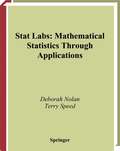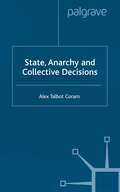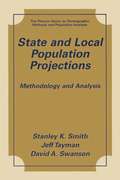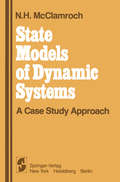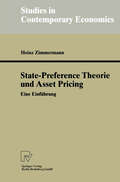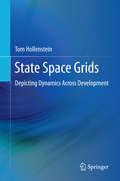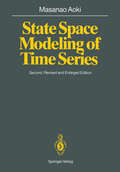- Table View
- List View
Starting Statistics: A Short, Clear Guide
by Neil BurdessStatistics: A Short, Clear Guide is an accessible, humorous and easy introduction to statistics for social science students. In this refreshing book, experienced author and academic Neil Burdess shows that statistics are not the result of some mysterious "black magic", but rather the result of some very basic arithmetic. Getting rid of confusing x′s and y′s, he shows that it′s the intellectual questions that come before and after the calculations that are important: (i) What are the best statistics to use with your data? and (ii) What do the calculated statistics tell you? Statistics: A Short, Clear Guide aims to help students make sense of the logic of statistics and to decide how best to use statistics to analyse their own data. What′s more, it is not reliant on students having access to any particular kind of statistical software package. This is a very useful book for any student in the social sciences doing a statistics course or needing to do statistics for themselves for the first time.
Starting Statistics: A Short, Clear Guide
by Neil BurdessStatistics: A Short, Clear Guide is an accessible, humorous and easy introduction to statistics for social science students. In this refreshing book, experienced author and academic Neil Burdess shows that statistics are not the result of some mysterious "black magic", but rather the result of some very basic arithmetic. Getting rid of confusing x′s and y′s, he shows that it′s the intellectual questions that come before and after the calculations that are important: (i) What are the best statistics to use with your data? and (ii) What do the calculated statistics tell you? Statistics: A Short, Clear Guide aims to help students make sense of the logic of statistics and to decide how best to use statistics to analyse their own data. What′s more, it is not reliant on students having access to any particular kind of statistical software package. This is a very useful book for any student in the social sciences doing a statistics course or needing to do statistics for themselves for the first time.
Starting with the Unit Circle: Background to Higher Analysis
by L.-K. HuaIt is with great pleasure that I am writing the preface for my little book, "Starting with the Unit Circle", in the office of Springer Verlag in Heidel berg. This is symbolic of the fact that I have once again joined in the main stream of scientific exchange between East and West. Since the establishment of the People's Republic of China, I have written "An Introduction to Number Theory" for the young people studying Number Theory: for the young people studying algebra, Prof. Wan Zhe-xian (Wan Che-hsien) and I have written "Classical Groups"; for those studying the theory of functions of several complex variables, I have written "Har monic Analysis of Functions of Several Complex Variables in the Classical Domains", * and for university students I have written "Introduction to Higher Mathematics". The present volume had been written for those who were beginning to engage in research at the Chinese University of Science and Technology and at the Guangdong Zhongshan University. Its purpose is none other than to make the students see the crucial ideas in their simplest manifestations, so that when they go on to the more complex parts of modem mathematics, they will not be without guidance. For example, in the first chapter when I point out that the Poisson kernel is just the Jacobian of some transformation, I am merely revealing the source of one of the main tools in my work on harmonic analysis in the classical domains.
Stat Labs: Mathematical Statistics Through Applications (Springer Texts in Statistics)
by Deborah Nolan Terry P. SpeedIntegrating the theory and practice of statistics through a series of case studies, each lab introduces a problem, provides some scientific background, suggests investigations for the data, and provides a summary of the theory used in each case. Aimed at upper-division students.
State, Anarchy, Collective Decisions: Some Applications of Game Theory to Political Economy
by A. CoramState, Anarchy and Collective Decisions provides an introduction to the applications of game theory to a series of questions that are fundamental in political economy. These questions include: Why do we need states? What might happen without protection for life and property? How might tribes or criminal gangs behave in struggles over material possessions? Would people tell the truth if asked what they wanted?
State and Local Population Projections: Methodology and Analysis (The Springer Series on Demographic Methods and Population Analysis)
by Stanley K. Smith Jeff Tayman David A. SwansonThe initial plans for this book sprang from a late-afternoon conversation in a hotel bar. All three authors were attending the 1996 meeting of the Population As- ciation of America in New Orleans. While nursing drinks and expounding on a variety of topics, we began talking about our current research projects. It so happened that all three of us had been entertaining the notion of writing a book on state and local population projections. Recognizing the enormity of the project for a single author, we quickly decided to collaborate. Had we not decided to work together, it is unlikely that this book ever would have been written. The last comprehensive treatment of state and local population projections was Don Pittenger’s excellent work Projecting State and Local Populations (1976). Many changes affecting the production of population projections have occurred since that time. Technological changes have led to vast increases in computing power, new data sources, the development of GIS, and the creation of the Internet. The procedures for applying a number of projection methods have changed considerably, and several completely new methods have been developed.
State-Dependent Impulses: Boundary Value Problems on Compact Interval (Atlantis Briefs in Differential Equations #6)
by Irena Rachůnková Jan TomečekThis book offers the reader a new approach to the solvability of boundary value problems with state-dependent impulses and provides recently obtained existence results for state dependent impulsive problems with general linear boundary conditions. It covers fixed-time impulsive boundary value problems both regular and singular and deals with higher order differential equations or with systems that are subject to general linear boundary conditions. We treat state-dependent impulsive boundary value problems, including a new approach giving effective conditions for the solvability of the Dirichlet problem with one state-dependent impulse condition and we show that the depicted approach can be extended to problems with a finite number of state-dependent impulses. We investigate the Sturm–Liouville boundary value problem for a more general right-hand side of a differential equation. Finally, we offer generalizations to higher order differential equations or differential systems subject to general linear boundary conditions.
State Management with React Query: Improve Developer And User Experience By Mastering Server State In React
by Daniel AfonsoImprove developer and user experience by mastering server state in React
State Management With React Query: Improve Developer And User Experience By Mastering Server State In React
by Daniel Afonso Ricardo MestreState Models of Dynamic Systems: A Case Study Approach
by N.H. McClamrochThe purpose of this book is to expose undergraduate students to the use of applied mathematics and physical argument as a basis for developing an understanding of the response characteristics, from a systems viewpoint, of a broad class of dynamic physical processes. This book was developed for use in the course ECE 355, Dynamic Systems and Modeling, in the Department of Electrical and Computer Engineering at the University of Michigan, Ann Arbor. The course ECE 355 has been elected primarily by junior and senior level students in computer engineering or in electrical engineering. Occasionally a student from outside these two programs elected the course. Thus the book is written with this class of students in mind. It is assumed that the reader has previous background in mathematics through calculus, differential equations, and Laplace transforms, in elementary physics, and in elemen tary mechanics and circuits. Although these prerequisites indicate the orientation of the material, the book should be accessible and of interest to students with a much wider spectrum of experience in applied mathemati cal topics. The subject matter of the book can be considered to form an introduc tion to the theory of mathematical systems presented from a modern, as opposed to a classical, point of view. A number of physical processes are examined where the underlying systems concepts can be clearly seen and grasped. The organization of the book around case study examples has evolved as a consequence of student suggestions.
The State of the Art in Computational Intelligence: Proceedings of the European Symposium on Computational Intelligence held in Košice, Slovak Republic, August 30-September 1, 2000 (Advances in Intelligent and Soft Computing #5)
by Peter Sincak L. A. Zadeh Jan Vascak D. E. Goldberg Vladimir Kvasnicka K. Fukushima Radko MesiarComputational Intelligence is a very dynamic domain of modern information society which integrates fields such as neural networks, fuzzy systems, evolutionary computation and intelligent systems in general. The book presents papers from the Euro-International Symposium on Computational Intelligence held in Kosice (Slovak Republic) in August 2000. It contains theoretical studies along with a chapter on applications and case studies. One of the main results of the symposium is that the combination of various techniques into hybrid intelligent systems will be very important for the development of intelligent information systems in the 21st century. The book also contains interesting forewords written by L.A. Zadeh, D.E. Goldberg, and K. Fukushima.
State of the Art in Computational Morphology: Workshop on Systems and Frameworks for Computational Morphology, SFCM 2009, Zurich, Switzerland, September 4, 2009, Proceedings (Communications in Computer and Information Science #41)
by Cerstin Mahlow Michael PiotrowskiFrom the point of view of computational linguistics, morphological resources are the basis for all higher-level applications. This is especially true for languages with a rich morphology, such as German or Finnish. A morphology component should thus be capable of analyzing single word forms as well as whole corpora. For many practical applications, not only morphological analysis, but also generation is required, i.e., the production of surfaces corresponding to speci?c categories. Apart from uses in computational linguistics, there are also numerous practical - plications that either require morphological analysis and generation or that can greatly bene?t from it, for example, in text processing, user interfaces, or information - trieval. These applications have speci?c requirements for morphological components, including requirements from software engineering, such as programming interfaces or robustness. In 1994, the First Morpholympics took place at the University of Erlangen- Nuremberg, a competition between several systems for the analysis and generation of German word forms. Eight systems participated in the First Morpholympics; the conference proceedings [1] thus give a very good overview of the state of the art in computational morphologyfor German as of 1994.
State of the Art in Global Optimization: Computational Methods and Applications (Nonconvex Optimization and Its Applications #7)
by Christodoulos A. Floudas Panos M. PardalosOptimization problems abound in most fields of science, engineering, and tech nology. In many of these problems it is necessary to compute the global optimum (or a good approximation) of a multivariable function. The variables that define the function to be optimized can be continuous and/or discrete and, in addition, many times satisfy certain constraints. Global optimization problems belong to the complexity class of NP-hard prob lems. Such problems are very difficult to solve. Traditional descent optimization algorithms based on local information are not adequate for solving these problems. In most cases of practical interest the number of local optima increases, on the aver age, exponentially with the size of the problem (number of variables). Furthermore, most of the traditional approaches fail to escape from a local optimum in order to continue the search for the global solution. Global optimization has received a lot of attention in the past ten years, due to the success of new algorithms for solving large classes of problems from diverse areas such as engineering design and control, computational chemistry and biology, structural optimization, computer science, operations research, and economics. This book contains refereed invited papers presented at the conference on "State of the Art in Global Optimization: Computational Methods and Applications" held at Princeton University, April 28-30, 1995. The conference presented current re search on global optimization and related applications in science and engineering. The papers included in this book cover a wide spectrum of approaches for solving global optimization problems and applications.
State of the Art in Partial Least Squares Structural Equation Modeling: Methodological Extensions and Applications in the Social Sciences and Beyond (Springer Proceedings in Business and Economics)
by Lăcrămioara Radomir Raluca Ciornea Huiwen Wang Yide Liu Christian M. Ringle Marko SarstedtThis edited volume brings together some of the best papers from the 2022 Conference on Partial Least Squares Structural Equation Modeling (PLS-SEM), held at the Babeș-Bolyai University, Cluj, Romania. The volume seeks to expand the current research on PLS-SEM and promote the method’s application in the scientific community. It gathers research from scholars in many different fields who work on the advancement of PLS-SEM and who apply the method to explain and predict behavioral phenomena. Researchers today can draw on a wide array of different PLS-SEM-based algorithms, complementary methods, and model evaluation metrics. Tying in with these developments, the first part of this book documents methodological advances of PLS-SEM, which extend the researchers’ current toolbox of methods. The following parts demonstrate state-of-the-art applications of PLS-SEM in various fields such as consumer behavior, hospitality, human resource management, entrepreneurship, and organizational behavior. Special emphasis is placed on studies that apply complementary methods to offer a more nuanced analysis of the research questions.
State-Preference Theorie und Asset Pricing: Eine Einführung (Studies in Contemporary Economics)
by Heinz ZimmermannDie State-Preference-Theorie bildet eine ideale analytische Basis zum Verständnis der ökonomischen Struktur moderner Kapitalmarktmodelle. Dieses Buch zeigt, wie ein einfaches State-Preference-Modell herangezogen werden kann, um die Bedingungen des Kapitalmarktgleichgewichts in diskreter und stetiger Zeit zu analysieren. Es handelt sich hierbei um einen einführenden Text, der zwar auf Mathematik und Statistik nicht verzichten kann, bei welchem allerdings ökonomische Überlegungen einen ebenso breiten Raum einnehmen. Das Buch schließt damit eine Lücke zwischen volkswirtschaftlichen, finanzmarkttheoretischen und auf stochastische Fragen ausgerichteten Lehrtexten.
A State Space Approach to Canonical Factorization with Applications (Operator Theory: Advances and Applications #200)
by Harm Bart Israel Gohberg Marinus A. Kaashoek André C.M. RanThe present book deals with canonical factorization of matrix and operator functions that appear in state space form or that can be transformed into such a form. A unified geometric approach is used. The main results are all expressed explicitly in terms of matrices or operators, which are parameters of the state space representation. The applications concern different classes of convolution equations. A large part the book deals with rational matrix functions only.
State Space Consistency and Differentiability (SpringerBriefs in Optimization)
by Demetrios SerakosBy investigating the properties of the natural state, this book presents an analysis of input-output systems with regard to the mathematical concept of state. The state of a system condenses the effects of past inputs to the system in a useful manner. This monograph emphasizes two main properties of the natural state; the first has to do with the possibility of determining the input-output system from its natural state set and the second deals with differentiability properties involving the natural state inherited from the input-output system, including differentiability of the natural state and natural state trajectories. The results presented in this title aid in modeling physical systems since system identification from a state set holds in most models. Researchers and engineers working in electrical, aerospace, mechanical, and chemical fields along with applied mathematicians working in systems or differential equations will find this title useful due to its rigorous mathematics.
State-Space Control Systems: The MATLAB®/Simulink® Approach (Synthesis Lectures on Control and Mechatronics)
by Farzin AsadiThese days, nearly all the engineering problem are solved with the aid of suitable computer packages. This book shows how MATLAB/Simulink could be used to solve state-space control problems. In this book, it is assumed that you are familiar with the theory and concepts of state-space control, i.e., you took or you are taking a course on state-space control system and you read this book in order to learn how to solve state-space control problems with the aid of MATLAB/Simulink. The book is composed of three chapters. Chapter 1 shows how a state-space mathematical model could be entered into the MATLAB/Simulink environment. Chapter 2 shows how a nonlinear system could be linearized around the desired opperating point with the aid of tools provided by MATLAB/Simulink. Finally, Chapter 3 shows how a state-space controller could be designed with the aid MATLAB and be tested with Simulink. The book will be usefull for students and practical engineers who want to design a state-space control system.
State Space Grids: Depicting Dynamics Across Development
by Tom HollensteinHuman development from birth through adulthood is a complex interplay of many interacting forces. Children’s internal processes are manifest in behaviors that are sculpted by their experiences, most notably with primary caregivers. Because the discipline of psychology explores human behavior and cognition, the techniques employed for developmental analysis must be able to describe, depict, and quantify these complex processes. State Space Grids provides the framework, basic method, rationale, and advanced techniques for translating the behavior of children, adolescents, and parents into visible, traceable data. This seminar-between-covers takes readers step by step from conceptualization through implementation of projects, with examples from a range of current research within and outside child development. Links are included for the GridWare software program and related user resources. And although state space grids need not be used only to analyze dynamic systems, they serve as an excellent tool for honing systemic thinking.Key coverage in this volume includes:Dynamic systems and the origins of state space grids.The state of research using state space grids.Introducing GridWare and how it works.How to use state space grids, from idea through finished project.Within-grid and between-grid analysis.Conducting advanced analysis.State Space Grids is an essential reference for researchers across such disciplines as psychology, neuroscience, economics, computer science, and agricultural science.
The State Space Method: Generalizations and Applications (Operator Theory: Advances and Applications #161)
by Daniel Alpay Israel GohbergThisvolumeofthe Operator Theory: Advances and Applications series (OTAA) isthe ?rst volume of a new subseries. This subseries is dedicated to connections between the theory of linear operators and the mathematical theory of linear systems and is named Linear Operators and Linear Systems (LOLS).Asthe- isting subseries Advances in Partial Di?erential Equations (ADPE), the new s- series will continue the traditions of the OTAA series and keep the high quality of the volumes. The editors of the new subseries are: Daniel Alpay (Beer–Sheva, - rael), Joseph Ball (Blacksburg, Virginia, USA) and Andr´ ´ e Ran (Amsterdam, The Netherlands). In the last 25–30 years, Mathematical System Theory developed in an ess- tial way. A large part of this development was connected with the use of the state space method. Let us mention for instance the “theory of H control”. The state ? space method allowed to introduce in system theory the modern tools of matrix and operator theory. On the other hand the state space approach had an imp- tant impact on Algebra, Analysis and Operator Theory. In particular it allowed to solve explicitly some problems from interpolation theory, theory of convolution equations, inverse problems for canonical di?erential equations and their discrete analogs. All these directions are planned to be present in the subseries LOLS. The editors and the publisher are inviting authors to submit their manuscripts for publication in this subseries.
State-Space Methods for Time Series Analysis: Theory, Applications and Software (Chapman & Hall/CRC Monographs on Statistics and Applied Probability)
by Jose Casals Alfredo Garcia-Hiernaux Miguel Jerez Sonia Sotoca A. Alexandre TrindadeThe state-space approach provides a formal framework where any result or procedure developed for a basic model can be seamlessly applied to a standard formulation written in state-space form. Moreover, it can accommodate with a reasonable effort nonstandard situations, such as observation errors, aggregation constraints, or missing in-sample values. Exploring the advantages of this approach, State-Space Methods for Time Series Analysis: Theory, Applications and Software presents many computational procedures that can be applied to a previously specified linear model in state-space form. After discussing the formulation of the state-space model, the book illustrates the flexibility of the state-space representation and covers the main state estimation algorithms: filtering and smoothing. It then shows how to compute the Gaussian likelihood for unknown coefficients in the state-space matrices of a given model before introducing subspace methods and their application. It also discusses signal extraction, describes two algorithms to obtain the VARMAX matrices corresponding to any linear state-space model, and addresses several issues relating to the aggregation and disaggregation of time series. The book concludes with a cross-sectional extension to the classical state-space formulation in order to accommodate longitudinal or panel data. Missing data is a common occurrence here, and the book explains imputation procedures necessary to treat missingness in both exogenous and endogenous variables. Web ResourceThe authors’ E4 MATLAB® toolbox offers all the computational procedures, administrative and analytical functions, and related materials for time series analysis. This flexible, powerful, and free software tool enables readers to replicate the practical examples in the text and apply the procedures to their own work.
State-Space Methods for Time Series Analysis: Theory, Applications and Software (Chapman & Hall/CRC Monographs on Statistics and Applied Probability)
by Jose Casals Alfredo Garcia-Hiernaux Miguel Jerez Sonia Sotoca A. Alexandre TrindadeThe state-space approach provides a formal framework where any result or procedure developed for a basic model can be seamlessly applied to a standard formulation written in state-space form. Moreover, it can accommodate with a reasonable effort nonstandard situations, such as observation errors, aggregation constraints, or missing in-sample values. Exploring the advantages of this approach, State-Space Methods for Time Series Analysis: Theory, Applications and Software presents many computational procedures that can be applied to a previously specified linear model in state-space form. After discussing the formulation of the state-space model, the book illustrates the flexibility of the state-space representation and covers the main state estimation algorithms: filtering and smoothing. It then shows how to compute the Gaussian likelihood for unknown coefficients in the state-space matrices of a given model before introducing subspace methods and their application. It also discusses signal extraction, describes two algorithms to obtain the VARMAX matrices corresponding to any linear state-space model, and addresses several issues relating to the aggregation and disaggregation of time series. The book concludes with a cross-sectional extension to the classical state-space formulation in order to accommodate longitudinal or panel data. Missing data is a common occurrence here, and the book explains imputation procedures necessary to treat missingness in both exogenous and endogenous variables. Web ResourceThe authors’ E4 MATLAB® toolbox offers all the computational procedures, administrative and analytical functions, and related materials for time series analysis. This flexible, powerful, and free software tool enables readers to replicate the practical examples in the text and apply the procedures to their own work.
State Space Modeling of Time Series (Universitext)
by Masanao AokiIn this book, the author adopts a state space approach to time series modeling to provide a new, computer-oriented method for building models for vector-valued time series. This second edition has been completely reorganized and rewritten. Background material leading up to the two types of estimators of the state space models is collected and presented coherently in four consecutive chapters. New, fuller descriptions are given of state space models for autoregressive models commonly used in the econometric and statistical literature. Backward innovation models are newly introduced in this edition in addition to the forward innovation models, and both are used to construct instrumental variable estimators for the model matrices. Further new items in this edition include statistical properties of the two types of estimators, more details on multiplier analysis and identification of structural models using estimated models, incorporation of exogenous signals and choice of model size. A whole new chapter is devoted to modeling of integrated, nearly integrated and co-integrated time series.
State-Space Models: Applications in Economics and Finance (Statistics and Econometrics for Finance #1)
by Yong Zeng and Shu WuState-space models as an important mathematical tool has been widely used in many different fields. This edited collection explores recent theoretical developments of the models and their applications in economics and finance. The book includes nonlinear and non-Gaussian time series models, regime-switching and hidden Markov models, continuous- or discrete-time state processes, and models of equally-spaced or irregularly-spaced (discrete or continuous) observations. The contributed chapters are divided into four parts. The first part is on Particle Filtering and Parameter Learning in Nonlinear State-Space Models. The second part focuses on the application of Linear State-Space Models in Macroeconomics and Finance. The third part deals with Hidden Markov Models, Regime Switching and Mathematical Finance and the fourth part is on Nonlinear State-Space Models for High Frequency Financial Data. The book will appeal to graduate students and researchers studying state-space modeling in economics, statistics, and mathematics, as well as to finance professionals.


